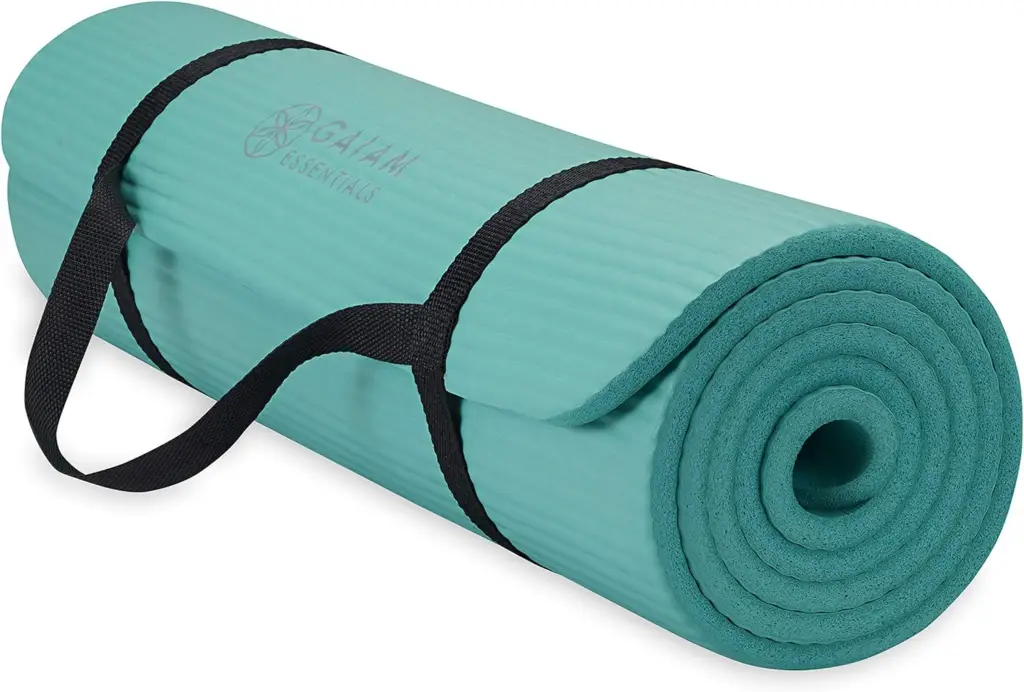Table of Contents Show
Yoga Mat PVC or EVA: Discover the key differences between PVC and EVA yoga mats, including their environmental impact, performance, portability, and price. Find out which material is best suited for your yoga practice.
If you’re on the hunt for the perfect yoga mat, you’ve probably stumbled upon the age-old question: “yoga mat PVC or EVA?” In this comprehensive and engaging article, we’ll dive deep into the world of yoga mats and help you decide which material is best for you. We’ll cover everything from eco-friendliness to performance, and by the end of it, you’ll be a veritable yoga mat connoisseur.
Disclosure: As an Amazon Associate I earn from qualifying purchases.
The Great Debate: Yoga Mat PVC or EVA – What’s the Difference?
Before we can answer the question “yoga mat PVC or EVA?” let’s first take a look at the two materials in question.
PVC – Polyvinyl Chloride
PVC, or polyvinyl chloride, is a synthetic plastic polymer that has been a popular choice for yoga mats for decades. Some of the reasons for its popularity include:
- Durability: PVC mats are known for their ability to withstand wear and tear, making them perfect for those who practice yoga regularly.
- Traction: PVC mats offer excellent grip, ensuring you don’t slip and slide during your practice.
- Price: PVC mats tend to be more affordable than their EVA counterparts.
EVA – Ethylene-Vinyl Acetate
EVA, or ethylene-vinyl acetate, is another synthetic plastic polymer that has gained popularity in recent years due to its eco-friendly properties. Some of the benefits of EVA include:
- Lightweight: EVA mats are lighter than PVC mats, making them easier to transport.
- Cushioning: EVA mats provide more cushioning than PVC mats, making them a more comfortable option for some practitioners.
- Eco-friendliness: EVA is considered a more environmentally friendly option than PVC.
Now that we’ve covered the basics of each material, let’s delve into some of the key factors to consider when choosing between a yoga mat PVC or EVA.
1. Environmental Impact: A Closer Look at the Eco-Friendliness of PVC and EVA
When it comes to environmental impact, EVA is often touted as the more eco-friendly option. But is that really the case? Let’s take a closer look.
PVC and the Environment
PVC has been criticized for its environmental impact. The production of PVC can release toxic chemicals, such as dioxins and phthalates, which can have harmful effects on both human health and the environment. Moreover, PVC is not biodegradable, which means that it can take hundreds of years to break down in a landfill.
That being said, there are some manufacturers who have made strides in creating more eco-friendly PVC yoga mats by using phthalate-free PVC or recycling PVC materials.
EVA and the Environment
EVA is considered to be a more environmentally friendly option because it doesn’t contain harmful phthalates or release toxic chemicals during production. Additionally, EVA is biodegradable, which means it breaks down more quickly than PVC.
However, it’s worth noting that the production of EVA still requires the use of non-renewable resources, such as petroleum.
2. Performance: Comparing Traction, Cushioning, and Durability
When choosing between a yoga mat PVC or EVA, it’s essential to consider how the mat will perform during your practice. Here’s how the two materials stack up in terms of traction, cushioning, and durability.
Traction
One of the most important aspects of a yoga mat is its ability to provide traction, ensuring you don’t slip during your practice. PVC mats are known for their excellent grip, even when wet with sweat. EVA mats, on the other hand, can be a bit slippery when wet, which may pose a problem for those who tend to sweat a lot during their practice. Some EVA mats are designed with a textured surface to improve traction, but they still might not offer the same level of grip as a PVC mat.
Cushioning
Cushioning is another essential factor to consider, as it can affect both your comfort and joint support during your practice. EVA mats are known for providing more cushioning than PVC mats, making them an ideal choice for those who prefer a softer surface or who have sensitive joints. However, some practitioners may find that the extra cushioning makes it more challenging to maintain balance during certain poses.
PVC mats, while not as cushioned as EVA mats, still offer adequate support and can be more suitable for those who prefer a firmer surface or require more stability during their practice.
Durability
When it comes to durability, PVC mats are the clear winner. They can withstand regular use and are less prone to tearing or wear, making them an excellent choice for those who practice yoga frequently or teach classes. EVA mats, while still durable, may not last as long as PVC mats, especially with heavy use.
3. Portability: Which Yoga Mat is Easier to Carry?
If you’re someone who travels with your yoga mat or brings it to and from classes, portability is an essential factor to consider. EVA mats are generally lighter than PVC mats, making them easier to transport. They also tend to be more flexible, which can make them easier to roll up and store in a yoga mat bag or strap.
PVC mats, while heavier and less flexible, are still portable, but may require more effort to carry around. If portability is a top priority for you, an EVA mat may be the better choice.
4. Price: Comparing the Costs of PVC and EVA Yoga Mats
Finally, let’s talk about price. PVC yoga mats tend to be more affordable than EVA mats, making them an attractive option for those on a budget. However, it’s essential to consider that a more expensive EVA mat may be a worthwhile investment if it better suits your needs and preferences.
It’s also worth noting that prices can vary greatly within each material category, depending on factors such as brand, thickness, and design features. Be sure to compare different options within your desired material type to find a mat that meets your needs and budget.
5. Allergies and Sensitivities: Are PVC or EVA Mats Better for Those with Allergies?
For some individuals, allergies, and sensitivities may play a role in choosing between a yoga mat PVC or EVA. Let’s explore how each material fares in this aspect.
PVC and Allergies
PVC mats are generally considered hypoallergenic, meaning they are unlikely to cause an allergic reaction in most people. However, some individuals may be sensitive to the chemicals used in the production of PVC or to the material itself. In such cases, it’s important to look for a PVC mat that is free of harmful phthalates and other potentially irritating chemicals.
EVA and Allergies
EVA mats are also typically hypoallergenic, but it’s important to note that some people may still experience an allergic reaction or sensitivity to the material. If you have a known sensitivity to synthetic materials, you may want to consider a natural alternative, such as a cork or natural rubber mat.
As with PVC mats, it’s essential to choose an EVA mat that is free of harmful chemicals and manufactured with minimal irritants.
6. Aesthetics and Design: Choosing a Yoga Mat that Reflects Your Personality
While performance and eco-friendliness are crucial factors to consider when choosing a yoga mat, let’s not forget about aesthetics and design. After all, your yoga mat should be a reflection of your personality and style.
PVC Mat Designs
PVC yoga mats come in a wide variety of colors, patterns, and designs, allowing you to find the perfect mat that suits your taste. From solid colors to intricate designs, there’s no shortage of options when it comes to PVC yoga mats.
EVA Mat Designs
EVA yoga mats also offer a range of colors and designs to choose from. While they may not be as widely available as PVC mats, you can still find an EVA mat that reflects your personal style.
When choosing a yoga mat, don’t be afraid to let your personality shine through. Whether you prefer a bold and colorful mat or a more subtle and minimalist design, there’s a yoga mat out there that’s perfect for you.
You May Also Like: The PVC Free Yoga Mat: 4 Transformative Benefits!
Conclusion: Yoga Mat PVC or EVA – The Choice is Yours
In conclusion, the choice between a yoga mat PVC or EVA ultimately comes down to your personal preferences and priorities. If you value eco-friendliness, lightweight portability, and cushioning, an EVA mat may be the best choice for you. On the other hand, if you prioritize durability, traction, and a more affordable price, a PVC mat may be the better option.
By considering the factors discussed in this article, you can make an informed decision that ensures your yoga practice is both comfortable and enjoyable.
FAQs
Q1: Is there a significant difference in the thickness of PVC and EVA yoga mats?
A: Both PVC and EVA yoga mats come in a variety of thicknesses, ranging from 1/8 inch (3mm) to 1/4 inch (6mm) or even thicker. The thickness you choose will depend on your personal preferences and needs in terms of cushioning and support.
Q2: Can I clean both PVC and EVA yoga mats the same way?
A: Both PVC and EVA yoga mats can be cleaned using a mild soap and water solution or a specialized yoga mat cleaner. However, it’s essential to follow the manufacturer’s cleaning instructions to ensure you don’t damage your mat. It’s also important to let your mat air dry completely before rolling it up to prevent the growth of bacteria or mold.
Q3: How often should I replace my yoga mat, whether it’s PVC or EVA?
A: The frequency with which you should replace your yoga mat will depend on the material, the quality of the mat, and the intensity of your practice. In general, PVC mats tend to last longer than EVA mats, often holding up well for several years with regular use. EVA mats, while still durable, may need to be replaced more frequently. Signs that it’s time to replace your mat include loss of traction, thinning, or tearing.
Q4: Are there any other eco-friendly alternatives to PVC and EVA yoga mats?
A: Yes, there are several eco-friendly alternatives to PVC and EVA yoga mats, such as those made from natural rubber, cork, or jute. These materials are more sustainable and biodegradable than synthetic plastic polymers, making them a great choice for those who prioritize environmental consciousness.
Q5: Can I use my PVC or EVA yoga mat for other types of exercise?
A: While PVC and EVA yoga mats are designed primarily for yoga practice, they can also be used for other types of low-impact exercises, such as Pilates or stretching routines. However, they may not be suitable for high-intensity workouts that require more stability or support.

